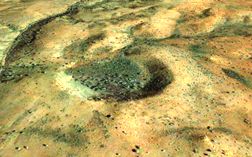
Hickman Crater?
Dr Arthur Hickman (Western Australian Geological Survey) has discovered a crater while engaged in research on channel ore deposits
1. This is a ‘rim crater’, one that has not eroded significantly from its original shape, and is only exceeded in size by the well-reserve Wolf(e) Creek Crater
2. The rim of the new find stands 80m above the floor, and mainly exposes rhyolite. The crater is 260m in diameter and its depth, allowing for infill is about 50m. The age is estimated as between 10,000 to 100,000 years. It sits on the top of a plateau about 36km from the iron-ore mining town of Newman, and it only visible from the air.
Alex Bevan of the Western Australian Museum has not seen it, but considers that it could only be a meteorite crater. The most likely impactor is an iron meteorite, though a stony meteorite is not impossible
3. An impactor diameter of c. 10m is likely, travelling at a speed of 5 km/sec on impact - exploding with energy release equivalent to 200,000-300,000 tons of TNT. It is possible that diligent search will reveal unaltered iron meteorite fragments nearby, as such fragments have been found close to the Barringer Crater, Arizona and the Wolfe Creek Crater, having separated from the falling mass before impact.
JMcC
Refs
- http://www.dailygalaxy.com/my_weblog/2008/04/major-impact-cr.html
- McCall, G.J.H. 1965. Possible meteorite craters: Wolf Creek and analogues. Annals of the New York Academy of Science 123 (Art2), 970-998.
- McCall, G.J.H. 2008. Carancas fall. Geoscientist 18(6); 5.